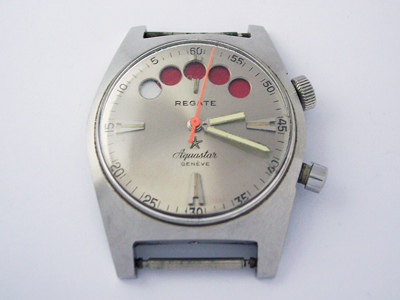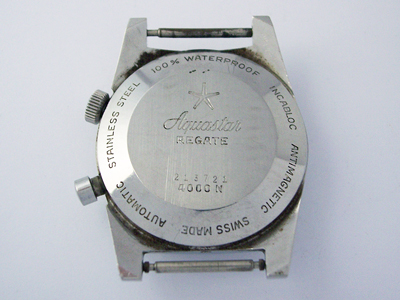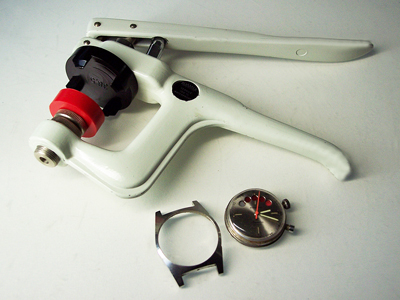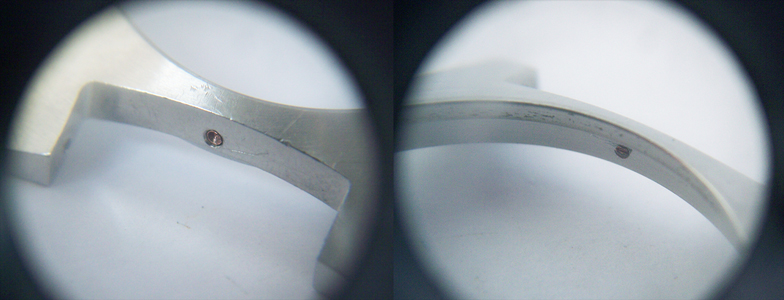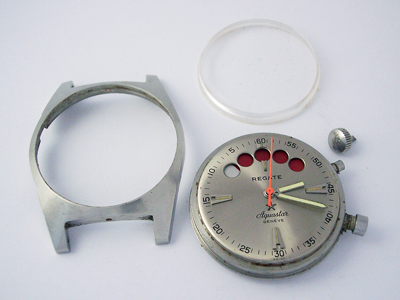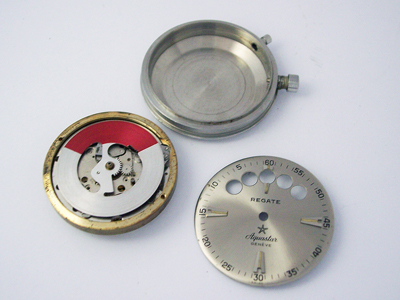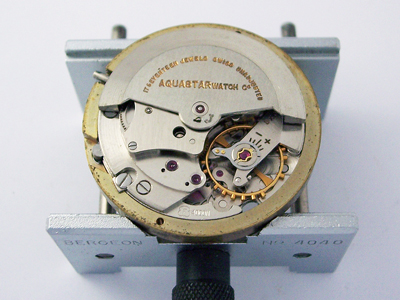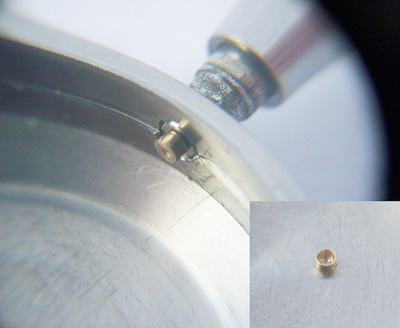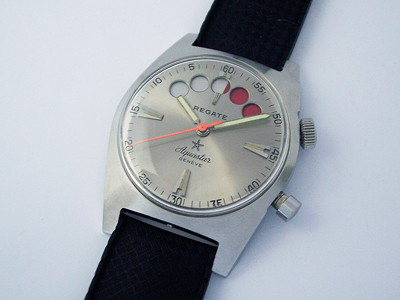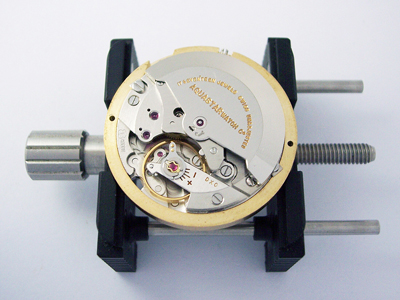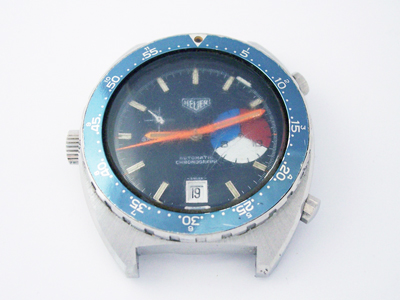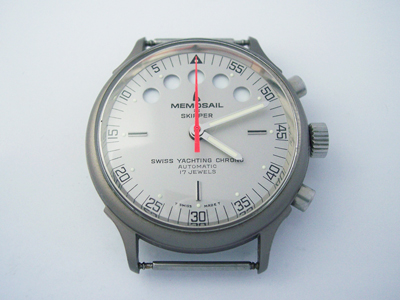Long-time readers will know that I’m a big fan of Aquastar watches, so let’s have a look at this Regate model.
(Click pictures to enlarge)
Though I’ve covered the first generation Regate model a couple of times already on the blog, this one is different to the others, and rarely seen, as it’s one of the very earliest models in the “monobloc” case.
Apart from a slight cut-out on the right-hand side, the watch looks very similar from the front, but turning the watch over, you aren’t met with Aquastar’s trademark ‘star’ patterned caseback. Instead the caseback is completely smooth giving the impression that it is a snap-on design.
Instead, the case consists of two parts, an inner section which houses the movement and an outer ‘top’ which is pressed over the crystal and inner case to form a seal – the design is similar to Roamer’s vintage Stingray and Anfibio models (an example here).
As you can probably tell by the amount of dirt around the caseback, this watch hadn’t been opened for many years and proved difficult to get apart. Thankfully, I have a set of Roamer case openers with exactly the right sized dies which helped immensely.
Rather than relying purely on friction between the casing parts, or the rubber gasket used in the second generation Regate models, the sharp-eyed amongst you may have spotted holes between the lugs on the outer case.
Two small brass pins are inserted into these holes which act as the locking mechanism between the inner and outer case parts. Being softer than steel, when the outer case is pressed over the inner case, the softer metal of the brass pins ‘give’ under the pressure and slot into a ridge on the inner case, locking the casing parts together.
With repeated opening and closing of the case, these pins will eventually wear out and would need to be replaced, but they were still in good condition on this watch.
Once separated, the crystal can be removed, and the two-piece stem separated to gain access to the movement.
Once apart, the differences between a standard first generation and the monobloc cased version don’t stop there. The first thing to note is that, like Aquastar’s Benthos 500, the movement is housed in a spacer ring which aligns it correctly in the lower case.
Second, unlike the Benthos, the dial is not secured with dial screws as you would expect, but the dial feet are merely located in holes in the spacer ring, and the dial held down by the crystal when in place. In practice, this isn’t a great design as when trying to case the watch or open it again to make any minor regulating tweaks, any lifting of the dial whilst handling the movement results in the timer disc under the dial jumping out of position, so the dial and hands have to be removed again to put things back in place.
The movement is the same modified Felsa cal. 4000N unit fitted to all first generation Regates. Rather than go into details about the modifications or how the timer works, I’ll direct any interested readers to this post where I covered the movement in more detail.
Although not running on arrival, the movement was relatively clean, just long overdue a service. The oils were pretty much dust throughout, so after a thorough clean and re-oil – and the inevitable battle with the timer mechanism – it was back in full working order. With the case cleaned and crystal polished, I was on the home stretch… or so I thought.
Although the timer mechanism worked perfectly out of the case, when cased it would only reset to just over four ‘red dots’ (minutes) on the dial, rather than five with the pusher pressed fully in. Gah! Having battled with timer already to get it working properly, and several more times to get the watch cased successfully, this was a real blow.
The problem suggested an issue with the pusher not travelling far enough into the case to push the timer disc all the way around, but on inspecting the pusher, there was no sign of damage and it was pressed fully into the outer case, so the only option I had was to make a brass cap for the pusher shaft to extend the reach.
However, that too proved problematic as when a cap long enough was in place to extend the reach far enough to push the timer disc all the way around, it wouldn’t clear the dots at the other end, leaving the last half a dot showing on the dial on completion. So, after several attempts, I had to compromise by leaving the timer showing around 4.75 minutes on the dial when fully pressed, but still clearing the dots on completion.
I’m rarely beaten by a watch, but the timer mechanisms on the early Regate (and the Benthos) models leave a lot to be desired from a design perspective, relying purely on friction. Factor in 60 year’s worth of wear on components that were discontinued decades ago, and compromises sometimes have to be made – for the sanity of the watchmaker if nothing else!
Rich.
** Many thanks to Henrik for letting me feature his watch on the blog. Be sure to check out Henrik’s website HeuerChrono if you’re interested in vintage sailing timers. **

